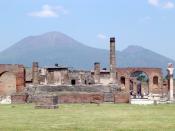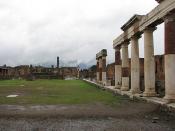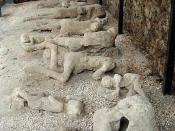The ancient cities of Pompeii and Herculaneum were once alive with activity beore the erruption of Mt Vesuvius in 79AD. In 1860 archaeological work revealed people, objects and buildings. These were buried approximately four metres under ash and pumice stones emitted from the volcanoe. Some examples of items found under the rubble are, theatres, amphitheatres, public baths, temples and administrative buildings. These finds give us an insight as to how the Pompeiians and the people of herculaneum lived their lives.
The oldest and most important building in Pompeii was the Basilica. The Basilica was a covered market and meeting place, until an earthquake occurring AD62 caused the roof to cave in, resulting in the Basilica becoming an open-air market. Another important building was the forum, which was usually surrounded by temples, shops and Basilicas. The forum had colonades around it. This is the part of the city is where the religious, commercial, and government activities took place.
It has become evident that the most important buildings such as forums Basilicas and baths are also what seem to be very busy places with lots of people using them. This suggests to us that the people of Pompeii and Herculaneum were very social people; they enjoyed being outdoors to watch shows, doing some shopping at the open-air markets and catching up with friends at the public baths.
The people of Pompeii loved to be entertained and the amphitheatre served as a venue for events such as Gladiatorial showdowns, fights between people and animals, and sporting events. We know this because Senca wrote about it in the 1st century AD. He said "I happened to call in at a midday show in the amphitheatre, expecting some sport, fun and relaxation. It was just the opposite. By comparison the fights that had...


